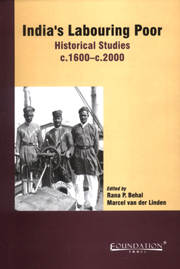Book contents
- Frontmatter
- Contents
- Notes on Contributors
- Frontispiece
- Preface
- Introduction
- Working Across the Seas: Indian Maritime Labourers in India, Britain, and in Between, 1600–1857
- The Brickmakers' Strikes on the Ganges Canal in 1848–1849
- On the Move: Circulating Labour in Pre-Colonial, Colonial, and Post-Colonial India
- Mobility and Containment: The Voyages of South Asian Seamen, c. 1900–1960
- Power Structure, Discipline and Labour in Assam Tea Plantations during Colonial Rule
- “Following Custom”? Representations of Community among Indian Immigrant Labour in the West Indies, 1880–1920
- Masculinity, Respect, and the Tragic: Themes of Proletarian Humor in Contemporary Industrial Delhi
- Stretching Labour Historiography: Pointers from South Asia
- DOCUMENT
- Select Bibliography
Power Structure, Discipline and Labour in Assam Tea Plantations during Colonial Rule
Published online by Cambridge University Press: 05 January 2012
- Frontmatter
- Contents
- Notes on Contributors
- Frontispiece
- Preface
- Introduction
- Working Across the Seas: Indian Maritime Labourers in India, Britain, and in Between, 1600–1857
- The Brickmakers' Strikes on the Ganges Canal in 1848–1849
- On the Move: Circulating Labour in Pre-Colonial, Colonial, and Post-Colonial India
- Mobility and Containment: The Voyages of South Asian Seamen, c. 1900–1960
- Power Structure, Discipline and Labour in Assam Tea Plantations during Colonial Rule
- “Following Custom”? Representations of Community among Indian Immigrant Labour in the West Indies, 1880–1920
- Masculinity, Respect, and the Tragic: Themes of Proletarian Humor in Contemporary Industrial Delhi
- Stretching Labour Historiography: Pointers from South Asia
- DOCUMENT
- Select Bibliography
Summary
The tea industry, from the 1840s onwards the earliest commercial enterprise established by private British capital in the Assam Valley, had been the major employer of wage labour there during colonial rule. It grew spectacularly during the last quarter of the nineteenth century, when tea production increased from 6,000,000 lb in 1872 to 75,000,000 lb in 1900 and the area under tea cultivation expanded from 27,000 acres to 204,000 acres. Employment of labour in the Assam Valley tea plantations increased from 107,847 in 1885 to 247,760 in 1900, and the industry continued to grow during the first half of the twentieth century. At the end of colonial rule the Assam Valley tea plantations employed nearly half a million labourers out of a labour population of more than three-quarters of a million, and more than 300,000 acres were under tea cultivation out of a total area of a million acres controlled by the tea companies.
This impressive expansion and the growth of the Assam Valley tea industry took place within the monopolistic control of British capital in Assam. An analysis of the list of companies shows that in 1942 84 per cent of tea estates with 89 per cent of the acreage in the Assam Valley were controlled by the European managing agency houses. Throughout India, thirteen leading agency houses of Calcutta controlled over 75 per cent of total tea production in 1939. Elsewhere I have shown that the tea companies reaped profits over a long time despite fluctuating international prices and slumps.
- Type
- Chapter
- Information
- India's Labouring PoorHistorical Studies, 1600-2000, pp. 143 - 172Publisher: Foundation BooksPrint publication year: 2007
- 1
- Cited by



